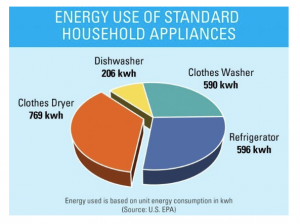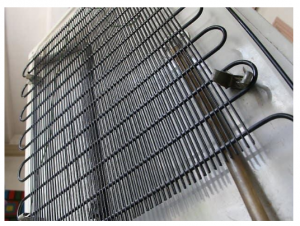Taming Your Power-Hungry Refrigerator
By Christopher Russell, Energy Program Manager
Refrigerators are indispensable household appliances and one of the largest electricity-consuming devices in the home. If your electricity bill makes you wince, you may find relief in the way you select and operate your refrigerator.
If you purchased a new refrigerator in the past four or five years, you are already ahead of the game. Refrigerators from 2014 perform the same job as refrigerators built in 1980, but they consume 60% less energy. Models available in 2020 are even more efficient. The savings come from built-in technology innovations.
Not ready to purchase a new refrigerator? You can still squeeze more efficiency out of the one you have. This involves reducing the workload on the motor. Whenever you hear your refrigerator “running,” it’s drawing power. So it pays to reduce the refrigerator’s run-time. There are several ways to do that.
Adjust the thermostat. 37° is sufficient for the chiller portion, while freezers should be set to zero degrees. Colder settings will only cost more money to sustain. If you do not have a visible thermostat in your refrigerator, you can purchase a dial one from most home improvement stores for under $6 dollars.
Minimize open-door frequency and duration. The longer or more often you open the refrigerator, you put more work on the motor. Develop a consistent pattern for placing items in the fridge, to reduce the time needed to “hunt” for things.
Clean the coils. Whenever you hear your refrigerator “running,” that noise is the condenser motor pumping coolant through evaporator coils attached either to the back of the refrigerator or on a chassis underneath. Over time, the coils collect dust especially if the household has furry pets. Clean coils are more efficient and require less power. Also, dirty refrigerator coils can be a fire hazard.
**WARNING** Maintenance of refrigerator coils is highly recommended. However, the task may be challenging, requiring some muscle and confidence in managing the refrigerator’s power and (if ice or water dispensers are included) water supply lines. When in doubt, obtain the services of a licensed professional.
Refrigerator coil cleaning is a good 1-2 hour project. Be sure to unplug the unit before cleaning it. Both a vacuum and a stiff brush are ideal for this project. Check your owner’s manual for more on this subject. You can also find YouTube videos. Coil-cleaning is relatively easy on the older models with exposed coils. On models manufactured about 15 years ago or earlier, refrigerator coils are readily accessible – if you can roll the fridge out from the wall or access the chassis underneath.
The task is harder on newer models, most of which are built with enclosed coils – with covers that are difficult if not impossible to remove. Note that these covers are not air-tight. They can still accumulate dust, lint and fur. Periodic cleaning is still recommended, but professional service may be preferable.
Avoid making a big mistake. Having obtained a new, efficient refrigerator for the kitchen, some people move the old “still perfectly good” fridge down to the basement, plug it in, and use it to store the occasional six pack of beer. In a basement location, a refrigerator’s coils are collecting dust, spider webs, pet fur, and perhaps lint from the clothes dryer. The basement fridge may have to work even harder because of these conditions. That work is reflected on your electric bill. Think twice about keeping that basement fridge. The same goes for that mini-fridge as well. If you really need a basement fridge, clean the coils once per year. If you can live without them, consider unplugging them – or even having them removed.



 1-888-373-7888
1-888-373-7888 233733
233733